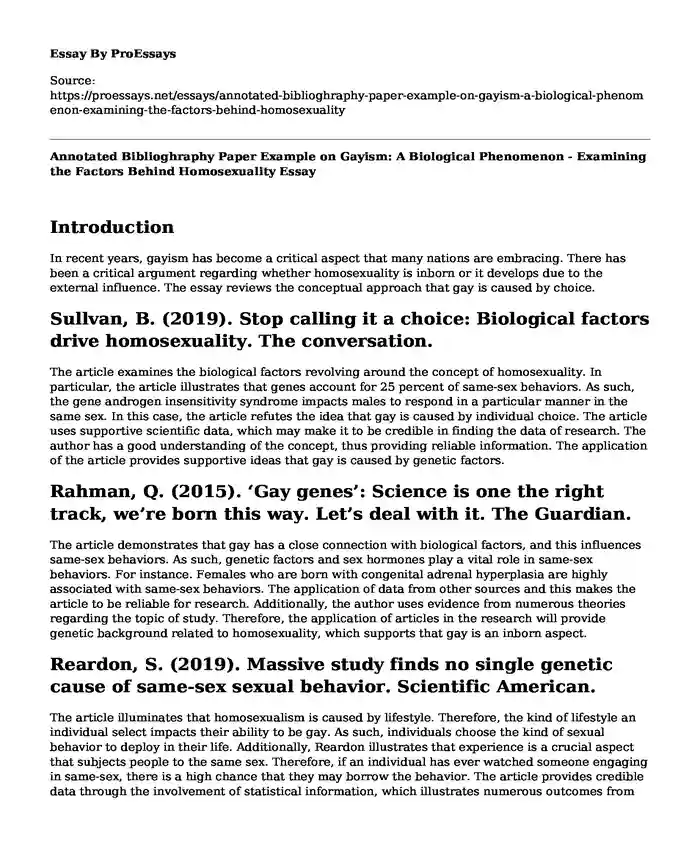Introduction
In recent years, gayism has become a critical aspect that many nations are embracing. There has been a critical argument regarding whether homosexuality is inborn or it develops due to the external influence. The essay reviews the conceptual approach that gay is caused by choice.
Sullvan, B. (2019). Stop calling it a choice: Biological factors drive homosexuality. The conversation.
The article examines the biological factors revolving around the concept of homosexuality. In particular, the article illustrates that genes account for 25 percent of same-sex behaviors. As such, the gene androgen insensitivity syndrome impacts males to respond in a particular manner in the same sex. In this case, the article refutes the idea that gay is caused by individual choice. The article uses supportive scientific data, which may make it to be credible in finding the data of research. The author has a good understanding of the concept, thus providing reliable information. The application of the article provides supportive ideas that gay is caused by genetic factors.
Rahman, Q. (2015). ‘Gay genes’: Science is one the right track, we’re born this way. Let’s deal with it. The Guardian.
The article demonstrates that gay has a close connection with biological factors, and this influences same-sex behaviors. As such, genetic factors and sex hormones play a vital role in same-sex behaviors. For instance. Females who are born with congenital adrenal hyperplasia are highly associated with same-sex behaviors. The application of data from other sources and this makes the article to be reliable for research. Additionally, the author uses evidence from numerous theories regarding the topic of study. Therefore, the application of articles in the research will provide genetic background related to homosexuality, which supports that gay is an inborn aspect.
Reardon, S. (2019). Massive study finds no single genetic cause of same-sex sexual behavior. Scientific American.
The article illuminates that homosexualism is caused by lifestyle. Therefore, the kind of lifestyle an individual select impacts their ability to be gay. As such, individuals choose the kind of sexual behavior to deploy in their life. Additionally, Reardon illustrates that experience is a crucial aspect that subjects people to the same sex. Therefore, if an individual has ever watched someone engaging in same-sex, there is a high chance that they may borrow the behavior. The article provides credible data through the involvement of statistical information, which illustrates numerous outcomes from several studies that the author uses to defend the position of the topic. Therefore, the application of the article will provide essential information for supporting that gay is triggered by the choice individuals take.
Tran, H., Ross, M. W., Diamond, P. M., Berg, R. C., Weatherburn, P., & Schmidt, A. J. (2018). Structural validation and multiple group assessment of the short internalized homonegativity scale in homosexual and bisexual men in 38 European countries: Results from the European MSM Internet Survey. The Journal of Sex Research, 55(4-5), 617-629.
The article illustrates that the environment plays a vital role in homosexuality. In this case, the article supports that gay is a choice, and environmental factors activate an individual to engage same-sex behavior. In this case, the kind of environment an individual lives impact their sexual behaviors. The viability of the article revolves around the way authors used in the collection of data. The article focuses on 38 European countries, which provide a good source of data for the study.
Conclusion
In conclusion, the essay supports the notion that gayism is caused by genetic factors. Genetic aspects influence an individual to develop same-sex behaviors. However, numerous studies refute the idea that gayism is caused by external influence.
References
Rahman, Q. (2015). ‘Gay genes’: Science is one the right track, we’re born this way. Let’s deal with it. The Guardian. https://www.theguardian.com/science/blog/2015/jul/24/gay-genes-science-is-on-the-right-track-were-born-this-way-lets-deal-with-it
Reardon, S. (2019). Massive study finds no single genetic cause of same-sex sexual behavior. Scientific American. https://www.scientificamerican.com/article/massive-study-finds-no-single-genetic-cause-of-same-sex-sexual-behavior/
Sullvan, B. (2019). Stop calling it a choice: Biological factors drive homosexuality. The conversation. https://theconversation.com/stop-calling-it-a-choice-biological-factors-drive-homosexuality-122764
Tran, H., Ross, M. W., Diamond, P. M., Berg, R. C., Weatherburn, P., & Schmidt, A. J. (2018). Structural validation and multiple group assessment of the short internalized homonegativity scale in homosexual and bisexual men in 38 European countries: Results from the European MSM Internet Survey. The Journal of Sex Research, 55(4-5), 617-629. https://www.sciencedirect.com/science/article/pii/S0277953612007952
Cite this page
Annotated Biblioghraphy Paper Example on Gayism: A Biological Phenomenon - Examining the Factors Behind Homosexuality. (2023, Sep 20). Retrieved from https://proessays.net/essays/annotated-biblioghraphy-paper-example-on-gayism-a-biological-phenomenon-examining-the-factors-behind-homosexuality
If you are the original author of this essay and no longer wish to have it published on the ProEssays website, please click below to request its removal:
- Effects of Light Intensity and Carbon Dioxide on Photosynthesis
- Eugenics and the Supreme Court Case of Buck vs. Bell
- Letter to Editor and Draft Initiative: Legalizing Gay Marriages in Arizona
- Sexual Orientation Development Essay
- Types and Numbers of Bird Species in Fragment Areas: Essay Sample on Matrix Dynamics and Isolation
- Research Paper on Psychosexual Development
- GMOs: Benefits and Risks in Feeding a Growing Population - Essay Sample







